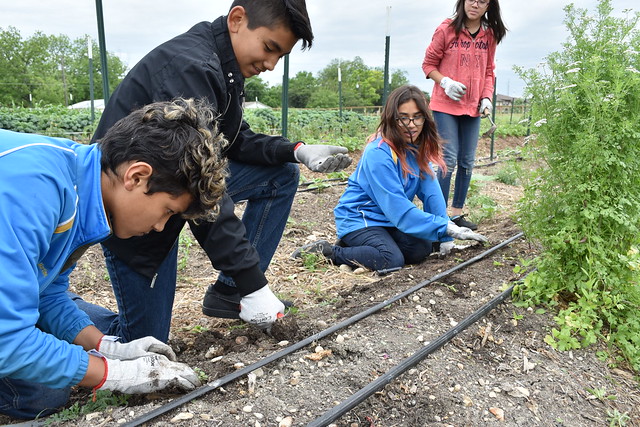
As we celebrate Farm to School Month this October, we can all feel the temperatures cooling down with the fall season. Here are seven ways USDA’s Farm to School Program can make your school and community ‘cooler’ throughout the year!
1. Delighting in Tasty Fruits

To kick-off Farm to School Month each year, students from pre-K to high school in Washington State celebrate Taste Washington Day. Students proudly bite into juicy, state-grown apples and then, in modern day fashion, the schools share their ‘crunches’ on social media. “Taste Washington Day offers our kids a chance to develop a better understanding of our state’s food system, from ‘farm to fork’ and each step in between,” says the Washington Department of Agriculture.
2. Connecting with the Earth – Growing Your Future

The Farm to School Grant Program funds garden projects that dash rich flavors onto students’ lunch trays. It’s an emerging trend in our nation’s school curricula, and for good reason. Beyond the savory “taste of the day,” these hands-on experiences shape America’s agricultural future. “Our nation’s food supply depends on more young people entering the field of agriculture as farmers retire,” said USDA Food and Nutrition Service Administrator Pam Miller. “Farm to school inspires young people to consider careers in agriculture and food systems.” This year, more than 60 percent of the farm to school projects funded by USDA supported the expansion of school gardening activities.
3. Trying Something New

Montana likes fresh new tastes in the lunchroom – and the kids look forward to the adventure! One of the state’s feature programs is “Harvest of the Month,” in which schools plan events around the appealing, locally grown foods that have been selected for the month. Childhood is the ideal time to establish healthy eating habits, and Farm to School does exactly that.
4. Enjoying Seasonably Fresh Vegetables

Farm to School happens all year round! This summer, students in Minnesota’s Roseville Area School District crunched on vegetables that were in season, even though regular classes were not in session, thanks to their local Farm to School Programs supporting a summer meals program – now that’s cool! They participated in the first ever Cucumber Crunch to encourage kids and teens to celebrate this locally grown treat. The students noticed – and LOVED – the seasonal freshness of the cucumbers. Farm to Summer is rapidly growing in the Gopher State, with more than 100 summer meal sites now participating. Check out this Roseville Area Schools Offer Local Produce to Students During Summer Food Program video to see how their schools provide locally grown produce to students during the summer.
5. Catching Seafood from a Coast Near You

The New England region proudly stretches the boundaries of Farm to School from land to sea. Red’s Best, a Boston-based regional seafood supplier, brings fresh fish into their local lunchrooms. Thanks to their contributions, students learn the importance of eating local, sustainably harvested fish, while anglers benefit from a stable market to sell their seafood. Farm to school is a win-win for everyone from students to teachers, parents, and producers!
6. Experiencing the Fruits (or Veggies) of Your Labor

Students in the North Clarion County School District in Pennsylvania planted potatoes, corn, and butternut squash in their school garden before summer break. When they returned in September, their families joined them at a Fall Harvest Celebration to feast on the veggies they planted. The abundance of appetizing produce proved well worth the wait! The school district plans to integrate more student-grown foods into school lunches, thanks to a $100,000 implementation grant from the USDA Farm to School Program.
7. Getting the Best Foods with Great Partnerships
Royal Food Service is a trusted source for schools to learn about quality local produce, market conditions, and peak-of-season produce. Even better – they provide produce to schools as a vendor of the Department of Defense Fresh Fruit and Vegetable Program (DoD Fresh). These efforts bring peaches and peppers – and many other fresh fruits and vegetables – to the plates of students across the country. According to the 2015 USDA Farm to School Census, 29 percent of districts participating in Farm to School received local foods through DoD Fresh. Take one small step to celebrate National Farm to School Month and find your local DoD Fresh vendor, today!
The Farm to School Grant Program has awarded nearly $40 million since 2013, funding more than 560 projects across the 50 states, the District of Columbia, Puerto Rico, Guam, and the Virgin Islands. To learn more about how this year’s grant winners are making their schools and communities cooler, please view the FY 2019 Farm to School List of Awardees (PDF, 375 KB).
Follow @USDANutrition on Twitter and stay tuned to the USDA Office of Community Food Systems website to learn when the next application cycle of Farm to School grants opens!

